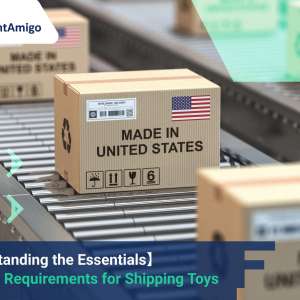In the world of international trade, documentation plays a pivotal role. Particularly when it comes to the import and export of toys into the US, the paperwork is often as significant as the goods themselves. This is because the documentation serves as a record of the transaction, provides information about the goods, and is crucial for regulatory compliance.
The first thing to understand is that the documentation for importing and exporting toys into the US is not just a mere formality. It’s a legal requirement, and failure to comply can result in severe penalties. These documents are also crucial for customs clearance. Without the proper documentation, customs may not allow the goods to enter or leave the country.
Furthermore, these documents play a significant role in logistics and supply chain operations. They help in tracking the shipment, ensuring that it reaches the correct destination, and confirming that the correct goods have been shipped. In short, the importance of documentation in toy import and export cannot be overstated.
Latest update on 12 January, 2024 by Aiden Ng– Marketing Analyst at FreightAmigo
Want to compare the best Express, Air Freight, Sea Freight, Rail Freight & Trucking rates so as to have better control on cost?
Comprehensive Guide to Documentation for Importing Toys into the US
Importing toys into the US requires a thorough understanding of the necessary documentation. The primary document is the Commercial Invoice. This document contains details about the seller and buyer, description of the goods, terms of delivery, and the price. It serves as a record of the transaction and is used by customs for valuation purposes.
The Bill of Lading or Airway Bill is another important document. This legal document issued by the carrier confirms the receipt of the goods and serves as a contract for their carriage. It also acts as a proof of ownership, making it a vital document for the importer.
For toys specifically, a Children’s Product Certificate (CPC) is necessary. This document certifies that the toy complies with all applicable children’s product safety rules. It is issued by the importer or the manufacturer and must accompany each shipment of toys.
Detailed Overview of Documentation for Exporting Toys from the US
Exporting toys from the US also involves a set of specific documents. Similar to imports, a Commercial Invoice and a Bill of Lading or Airway Bill are required. Additionally, an Export Packing List is necessary. This list provides detailed information about the packaging of the goods, including the number and type of packages, their weights and measurements, and the content of each package.
If the toys are being exported to a country with which the US has a Free Trade Agreement (FTA), a Certificate of Origin may be required. This document certifies that the goods meet the requirements to qualify for the FTA and can therefore benefit from reduced or eliminated tariffs.
In certain cases, an Export License may be required. This license is issued by the US government and grants permission to export certain goods. While most toys do not require an Export License, it’s crucial to check the specific regulations.
Common Challenges in Handling Documentation for Toy Import and Export
Dealing with the documentation for importing and exporting toys into the US can be challenging. One common challenge is keeping up with the ever-changing regulations. The requirements can change frequently, and importers and exporters need to stay updated to ensure compliance.
Another challenge is the complexity involved in filling out the documents. Each document requires specific information, and any errors can lead to delays, fines, or even the seizure of the goods.
The volume of paperwork can also be overwhelming. Each shipment requires multiple documents, and managing this paperwork can be a daunting task, especially for businesses dealing with multiple shipments.
Steps to Ensure Compliance in Toy Import and Export Documentation
Ensuring compliance in toy import and export documentation requires careful planning and execution. The first step is to understand the necessary documents and their requirements. This includes not only the standard import and export documents but also any additional certificates or licenses required for toys specifically.
Next, it’s essential to keep up-to-date with any changes in the regulations. This may involve subscribing to updates from regulatory bodies, attending industry seminars, or working with a customs broker or trade consultant.
Accuracy in filling out the documents is also crucial. Any errors can have serious consequences, so it’s worth taking the time to double-check all information. Using software or services for document management can help in managing the volume of paperwork and ensuring accuracy.
Expert Advice on Streamlining the Documentation Process for Toy Import and Export
Experts in the field of import and export suggest several strategies to streamline the documentation process. One recommendation is to use technology. There are several software solutions available that can automate much of the paperwork, reducing errors and saving time.
Another suggestion is to work with a customs broker or trade consultant. These professionals are familiar with the regulations and documentation requirements and can handle much of the paperwork on behalf of the business.
Finally, experts recommend maintaining a systematic record of all transactions. Keeping a well-organized archive of all import and export documents can help in case of audits, disagreements, or disputes.
Conclusion: Navigating the Paperwork Maze for Toy Imports and Exports
In conclusion, the documentation for importing and exporting toys into the US can seem like a complex maze. However, with a good understanding of the required documents, an up-to-date knowledge of regulations, accurate record-keeping, and the use of technology or professional services, it’s possible to navigate this maze successfully. So, while the paperwork may seem daunting, it’s a vital part of the import and export process that can be managed effectively with the right approach.
There are different options for cargo transportation. If you want to choose the most convenient and suitable solution, it is best to have the full support of logistics experts! If you are planning to ship goods overseas, please go to the FreightAmigo page for inquiries.
===
Read More:
【The Comprehensive Guide to Toy Shipping】 Regulations, Customs, and Best Practices
How to Package Toys for Shipping: Protecting Your Products and Delighting Customers
【Mastering the Rules】 How to Comply with Regulations for Importing and Exporting Toys
【Understanding the Essentials】 Labeling Requirements for Shipping Toys
【Safety First】 Unpacking the Product Testing Rules for US Imported Toys
===
If you have any inquiries on logistics/supply chain, feel free to contact FreightAmigo now:
Hotline: +852 28121686
WhatsApp: +852 27467829



